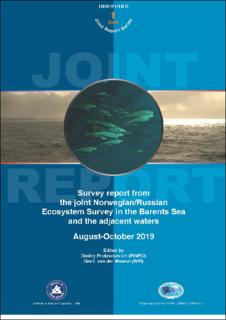| dc.contributor.editor | Prozorkevich, Dmitry | |
| dc.contributor.editor | van der Meeren, Gro Ingleid | |
| dc.date.accessioned | 2021-05-19T07:48:05Z | |
| dc.date.available | 2021-05-19T07:48:05Z | |
| dc.date.created | 2021-05-18T13:01:19Z | |
| dc.date.issued | 2020 | |
| dc.identifier.uri | https://hdl.handle.net/11250/2755575 | |
| dc.description.abstract | The aim of the joint Norwegian/Russian ecosystem survey in the Barents Sea and adjacent waters, August-October (BESS) is to monitor the status of abiotic and biotic factors and changes of these in the Barents Sea ecosystem. The survey has since 2004 been conducted annually in the autumn, as a collaboration between the Institute of Marine Research (IMR) in Norway and Polar branch of the VNIRO (PINRO) in Russia. The general survey plan and tasks are agreed upon at the annual IMR-PINRO Meeting in March. Ship routes and other technical details are agreed on by correspondence between the survey coordinators. BESS aims to cover the entire, ice-free area of the Barents Sea. Ecosystem stations are distributed in a 35×35 nautical mile regular grid, and the ship tracks follow this design. Exceptions are the area around Svalbard (Spitsbergen), some additional bottom trawl hauls for demersal fish survey index estimation, and additional acoustic transects for the capelin stock size estimation. Due to technical problems, deviations from the general design resulted in reduced coverage of the survey area in 2019. The 17-th joint Barents Sea autumn Ecosystem Survey (BESS) was carried out during the period from 13-th August to 04-th October 2019 by the Norwegian research vessels: “G.O. Sars”, “Johan Hjort”, and “Helmer Hanssen”, and the Russian vessel “Vilnyus”. Survey coordinators in 2019 was Dmitry Prozorkevich (PINRO) and Geir Odd Johansen (IMR). 2 Russian experts participated in the Norwegian vessels in 2019. We would like to express our sincere gratitude to all the crew and scientific personnel onboard RVs “Vilnyus”, “G.O. Sars”, “Johan Hjort” and “Helmer Hanssen” for their dedicated work, as well as all the people involved in planning and reporting of BESS 2019. Photos and video documentation of the survey routines was taken at Norwegian vessels to start building up a freely available collection of documentation of the methods used at BESS. This report is a summary of the observations and status assessments based on the survey data. Further interpretation on drives, trends and consequences will be reported by ICES WGIBAR and other ICES working group reports. | en_US |
| dc.language.iso | eng | en_US |
| dc.publisher | Havforskningsinstituttet | en_US |
| dc.relation.ispartof | IMR/PINRO Joint Report Series | |
| dc.relation.ispartofseries | IMR/PINRO Joint Report Series; | |
| dc.relation.ispartofseries | ;2020 - 1 | |
| dc.relation.uri | https://www.hi.no/resources/IMR-PINRO-Report-2019-survey.pdf | |
| dc.title | Survey report from the joint Norwegian/ Russian ecosystem survey in the Barents Sea and adjacent waters August-October 2019 | en_US |
| dc.type | Research report | en_US |
| dc.description.version | publishedVersion | en_US |
| dc.source.pagenumber | 93 | en_US |
| dc.source.volume | 2020 | en_US |
| dc.source.issue | 2020 - 01 | en_US |
| dc.identifier.cristin | 1910504 | |
| dc.relation.project | Havforskningsinstituttet: 14153 | en_US |
| cristin.ispublished | true | |
| cristin.fulltext | original | |
